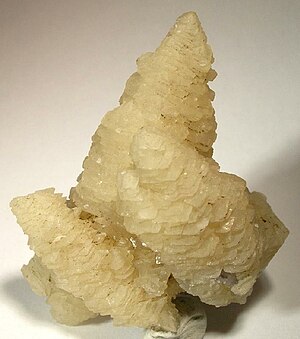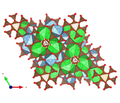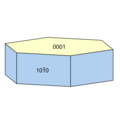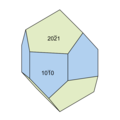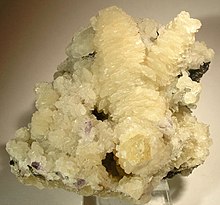Benstonite
| Benstonite | |
|---|---|
| Whitish benstonite encrusted with white, pointed scalenohedral calcite crystals on fluorite . "Mahoning No. 1 Mine “(also Minerva No. 1 Mine), Illinois-Kentucky Fluorspar District, Hardin Co. , Illinois , USA . Step size: 15.4 x 12.2 x 11.9 cm. | |
| General and classification | |
| chemical formula |
|
|
Mineral class (and possibly department) |
Carbonates and nitrates - carbonates without additional anions; without H 2 O |
|
System no. to Strunz and to Dana |
5.AB.55 ( 8th edition : Vb / A.03b) 02/14/03/01 |
| Crystallographic Data | |
| Crystal system | trigonal |
| Crystal class ; symbol | trigonal-rhombohedral; 3 |
| Space group | R 3 (No. 148) |
| Lattice parameters | a = 18.280 Å ; c = 8.652 Å |
| Formula units | Z = 3 |
| Physical Properties | |
| Mohs hardness | 3 to 4 |
| Density (g / cm 3 ) | 3.596 to 3.66 (measured); 3,695 (calculated) |
| Cleavage | good after {31 4 2} |
| Break ; Tenacity | no information in the literature; no information in the literature |
| colour | snow white, ivory, pale yellow, pale yellowish brown |
| Line color | White |
| transparency | translucent |
| shine | Glass gloss |
| Crystal optics | |
| Refractive indices |
n ω = 1.690 n ε = 1.527 |
| Birefringence | δ = 0.163 |
| Optical character | uniaxial negative |
| Pleochroism | none |
| Other properties | |
| Chemical behavior | soluble in HCl |
| Special features | Orange-colored fluorescence in long-wave and red to violet-pink fluorescence in short-wave UV light and under the X-ray beam. Phosphorescence lasting several minutes. |
Benstonite is a rarely occurring mineral from the mineral class of " carbonates and nitrates " (formerly carbonates, nitrates and borates ). It crystallizes in the trigonal crystal system with the idealized chemical composition Ba 6 Ca 6 Mg (CO 3 ) 13 - chemically speaking it is therefore a barium - calcium - magnesium - carbonate .
Benstonite forms rhombohedral crystals up to 1 cm in size and typically fissile mineral aggregates with a fine mosaic structure .
The type locality of the benstonite is the "Baroid Mine" (or the Chamberlain Creek Barite Mines) belonging to the open pit of the "Baroid Sales Division" ( coordinates of the open pit of the "Baroid Sales Division" ) in Chamberlain Creek Valley near Magnet Cove , Hot Spring County , Arkansas , United States .
Etymology and history
At the beginning of the 1950s, the ore processing metallurgist Orlando J. Benston of the Baroid Division, National Lead Company, Malvern , Arkansas, examined a carbonate mineral from the "Baroid Mine" and suggested from qualitative chemical tests and the density of about 3.60 g / cm³ that this is alstonite or barytocalcite . During a visit by the German mineralogist Friedrich Lippmann to the "Baroid Mine" at New Year's 1954, Benston made specimens of the mineral in question available to him. Mineralogical investigations to determine the physical and optical properties as well as X-ray diffractometric and chemical investigations showed that it was a new mineral.
In 1961, the first scientific description of this mineral was made by Friedrich Lippmann in the German science magazine " Naturwissenschaften " as benstonite ( English benstonite ). He named the mineral after the finder Orlando J. Benston (1901-1966), who had also carried out the first investigations on this mineral. Another extensive work on the mineralogical, crystal-optical, X-ray diffractometric and chemical properties of benstonite was published by Lippmann in the US scientific magazine "The American Mineralogist".
The mineral was recognized as a mineral by the "Commission on New Minerals and Mineral Names" of the International Mineralogical Association (IMA) in a 1967 report that summarized the 129 initial descriptions from 1961 to 1964. As a result, Benstonit does not have an IMA number, but is managed under the collective recognition “IMA 1967 sp” ( special procedure ).
The type of material for Benstonit is under the catalog numbers 120234 (Donation OJ Benston via F. Lippmann, 1967) and 120236 (Donation F. Lippmann, collected on 31 December 1954) in the collection of the Smithsonian Institution belonging to National Museum of Natural History in Washington , DC , USA . The holotype level should be found under catalog number S.21.3.5.1 in the mineralogical collections in the Mineralogical-Petrographic Institute of the Georg-August-Universität Göttingen , Göttingen , Germany , but the " Type Mineral Catalog Germany" does not contain any information in this regard.
Despite the very similar name, benstonite has nothing to do with the rock bentonite, which is a mixture of different clay minerals , and must not be confused with it.
classification
In the 8th edition of the mineral classification according to Strunz , benstonite belonged to the common mineral class of "carbonates, nitrates and borates" and there to the department of "carbonates", where together with huntite it belongs to the "norsethite series" consisting only of norsethite with the system -No. Vb / A.03b within the subsection “Anhydrous carbonates without foreign anions ” was added.
In the last revised and updated Lapis mineral directory in 2018 , which is still based on this outdated system of Karl Hugo Strunz out of consideration for private collectors and institutional collections , the mineral was given the system and mineral number. V / B.03-080 . In the "Lapis system" this corresponds to the department "Anhydrous carbonates [CO 3 ] 2− , without foreign anions ", where benstonite together with dolomite , anchorite , kutnohorite , minrecordite , norsethite and huntite form the dolomite group with the number V / B.03 forms.
The 9th edition of Strunz's mineral systematics, which has been valid since 2001 and updated by the International Mineralogical Association (IMA) until 2009, assigns benstonite to the “carbonates and nitrates” class, which has been reduced by borates, and to the “carbonates without additional” class Anions; without H 2 O “. This is further subdivided according to the group membership of the cations involved , so that the mineral can be found according to its composition in the sub-section "alkaline earth (and other M 2+ ) carbonates", where the unnamed group with the system no . 5.AB.55 forms.
The systematics of minerals according to Dana , which is mainly used in the English-speaking world , assigns benstonite, like the old Strunz system, to the common class of “carbonates, nitrates and borates” and there to the department of “anhydrous carbonates”. Here he is to be found as the only member of the unnamed group 02/14/03 within the sub-section “Anhydrous carbonates with the formula A + B 2+ (CO 3 ) 2 ”.
Chemism
A wet chemical analysis by Friedrich Lippmann on 10 g of homogeneous fragments of benstonite from the type locality that had been picked out showed 43.05% BaO; 4.02% SrO; 19.52% CaO; 1.69% MgO; 0.35% MnO and 31.35% CO 2 (total 99.98%). The empirical formula (Ba 5.27 Sr 0.73 ) Σ = 6.00 Ca 6.00 (Mg 0.79 Ca 0.12 Mn 0.09 ) Σ = 1.00 is calculated on the basis of thirteen cations (CO 3 ) 13 , which can be simplified to Ba 6 Ca 6 Mg (CO 3 ) 13 .
Mg-deficient strontium benstonite has been detected for the first time from "Ust'-Biraya" (also "Birainskoe", Irkutsk Oblast , Russia ), where the mineral occurs as accessory ore in fenites of the host rock , but up to 35% in the Composition of some hydrothermal veins . The chemical composition of benstonite from Birainskoe is very different. Five different varieties can be distinguished. Two of them can be found primarily in the corridors as the main minerals:
- (Ва 3.25 Sr 2.75 ) Σ = 6.00 (Са 5.42 Sr 0.36 (La 0.13 Се 0.07 Pr 0.01 Nd 0.01 ) 0.22 ) Σ = 6, 00 (Са 0.50 Мg 0.33 Fе 0.05 Mn 0.02 ) Σ = 0.90 [СО 3 ] 13
- (Ва 4.20 Sr 4.80 ) Σ = 6.00 (Са 5.74 Sr 0.24 La 0.02 ) Σ = 6.00 (Мg 0.51 Са 0.29 Fе 0.09 Mn 0, 04 ) Σ = 0.93 [СО 3 ] 13
- The standard and Mg-free benstonite and its varieties with Sr> Ва are only available here in small and accessory quantities.
The official formula of the IMA for benstonite is given as Ba 6 Ca 6 Mg (CO 3 ) 13 . The formula according to Strunz, Ba 6 Ca 6 Mg [CO 3 ] 13 follows the IMA-compliant formula, but here, as usual, the anion group is summarized in square brackets.
The only combination of elements Ba – Ca – Mg – C – O, as can be found in the official IMA formula for benstonite, only has the unnamed phase UM1974-03-CO: BaCaMg among the currently known minerals (as of 2019) in addition to benstonite , (Ba, Ca, Mg) CO 3 .
Crystal structure
Benstonite crystallizes in the trigonal crystal system in the space group R 3 (space group no. 148) with the lattice parameters a = 18.280 Å and c = 8.652 Å as well as three formula units per unit cell .
| Crystal structure of benstonite. The orange outline shows the unit cell. |
|
|
| Color legend: __ Ba __ Ca __ Mg __ C __ O |
Benstonite is structurally related to calcite . Its crystal structure (compare the illustrations opposite) consists of a CO 2 group arranged in parallel (0001) and twelve CO 2 groups slightly inclined towards (0001) . There are three tenfold coordinated barium atoms Ba [10] , three ninefold coordinated barium atoms Ba [9] , six (7 + 1) -coordinated calcium atoms Ca [7 + 1] and one sixfold coordinated magnesium per formula unit of benstonite Atom of Mg [6] . The barium atoms are therefore in two different positions: 50% are nine-fold and 50% are ten-fold coordinated. The superstructure of benstonite therefore appears to contain an order within the cation layers.
properties
morphology
Benstonite typically forms fissile masses with cleavage surfaces up to a size of one centimeter, which have a fine mosaic structure as in some dolomites or siderites . These fissure fragments are more or less perfect rhombohedra of the same shape as calcite and the other rhombohedral carbonates. Furthermore, benstonite can form rhombohedral crystals up to 1 cm in size. According to Ulrich Baumgärtel, it is the rhombohedron {10 1 1} or the rhombohedron {20 2 1}. There are also combinations of the prism {10 1 0} with the basic pinacoid {0001} or the rhombohedron {20 2 1} (compare the crystal drawings on the right).
- Costume and habit of benstonite crystals
physical and chemical properties
The crystals of benstonite are snow-white, ivory-colored, pale yellow or pale yellowish brown. Their line color , however, is always white. The surfaces of the translucent crystals of benstonite show a characteristic glass-like sheen . According to this glass gloss, benstonite has a medium to high light refraction ( n ε = 1.527; n ω = 1.690) and - like many carbonate minerals - a very high birefringence (δ = 0.163). In transmitted light, the uniaxial negative benstonite is colorless and shows no pleochroism .
Benstonite shows good cleavage properties according to {31 4 2}, but it is not as perfect as that of calcite. Information on tenacity and breakage of the mineral is missing. Benstonite has a Mohs hardness of 3 to 4 and is therefore one of the medium-hard minerals that, if the crystal size is appropriate, such as the reference mineral calcite (hardness 3), can be easily scratched with a copper coin or the reference mineral fluorite (hardness 4) with a pocket knife. The measured density for benstonite is, depending on the author, values between 3.596 and 3.66 g / cm³, the calculated density is 3.695 g / cm³.
Benstonite shows an orange fluorescence in long-wave UV light (365 nm) and a red, rarely also a violet-pink fluorescence in short-wave UV light (254 nm) . Phosphorescence is noticeable at 20 kilovolts. At 50 kilovolts, the afterglow lasts a few minutes. Red fluorescence also occurs when exposed to X-rays . The most common activator is Mn 2+ .
The mineral dissolves in dilute hydrochloric acid , HCl.
Education and Locations
The type locality of Benstonits is located in a barite - deposit (Magnet Cove, Arkansas / USA); the second site (Minerva No. 1 mine near Cave-in-Rock, Illinois / USA) is a former zinc ore and fluorspar mine . In the gigantic SEE Fe-Nb deposit of Bayan Obo , China, benstonite is found in alpinotypes , through a carbonatite- setting corridors.
As early as 1973, William C. Hood and Peter F. Steidl succeeded in synthesizing benstonite crystals at room temperature .
Minerals accompanying benstonite are barite, calcite, milk quartz (Magnet Cove, Arkansas, USA); Calcite, alstonite , fluorite, sphalerite (Cave-in-Rock, Illinois, USA); Huntite , barytocalcite , strontianite , pyrite , phlogopite , monazite and daqingshanite (“Bayan Obo” deposit, China). In the latter deposit, Ba- and Sr-containing carbonate minerals such as benstonite, norsethite, barytocalcite, strontianite and Sr-calcite occur as late-stage formations and replace carbonatic host rocks along the grain boundaries. The Ba-containing carbonate minerals obviously cannot be derived from barite, one of the most common gangue minerals.
As a rarely occurring mineral formation, benstonite is only known from a few localities or in a small number of stages. So far (as of 2020), the mineral has been described by around 20 sites in addition to its type locality. The benstonite type locality are mineralized veins in a barite ore body in the Baroid Sales Division's "Baroid Mine" in the Chamberlain Creek Valley near Magnet Cove , Hot Spring County , Arkansas , United States . This open pit mine was operated by the "Baroid Sales Division of the National Lead Company and the Magnet Cove Barium Company", a subsidiary of Dresser Industries at the time. The open pit exploited the flatter eastern part of the barite deposit. The deposit had been in production since 1939 and was dropped in 1977.
Other locations for benstonite are:
- the salt lake "North Ingebright", Saskatchewan , Canada
- the Jason and Tom stratiform lead - zinc deposits, Macmillan Pass, Watson Lake Mining District, Yukon , Canada
- the "West Mine" of the huge polygenetic REE - iron - niobium deposit Bayan-Obo in the mining district of Bayan-Obo north of the Bayan-Obo district of the district-free city of Baotou , Inner Mongolia Autonomous Region in the People's Republic of China
- the Kirki Mines (Kirka), Evros , East Macedonia and Thrace , Greece
- the Samalpatti carbonatite complex in the Krishnagiri District , Tamil Nadu , India
- Vein- shaped carbonatites in the Salem area , Salem Attur Fault Zone, Salem District , Tamil Nadu, India
- the alkali rock massif "Salampatti" near Tirupathur , Vellore District , Tamil Nadu, India
- the "Miniera di Monte Arsiccio" at Sant'Anna di Stazzema , Stazzema , Province of Lucca , Tuscany , Italy
- the Pb-Zn-Ag deposit of the "Rosh Pinah Mine" near Rosh Pinah , Oranjemund , Region , ǁKaras , Namibia
- the manganese belt of Bistriţa, Romania
- “Ust'-Biraya” in the area of the Fe-SEE ore outcrops “Biraya” at the confluence of Biraya and Bya in the Chara basin on the Witim plateau , Irkutsk oblast , Russia
- the Murunskii alkaline rock massif ( Russian Мурунский массив ) at the confluence of the Tschara and Tokko in the Aldan highlands , Sakha Republic (Yakutia) , Far East Federal District , Russia
- the metamorphic Fe-Mn deposit Långban , Filipstad municipality , Värmland County or the historic Värmland province in central Sweden
- the “Minerva No.” belonging to the “Ozark-Mahoning Group”. 1 Mine ”(also known as“ Ozark-Mahoning No. 1 Mine ”) at Cave-in-Rock not far from Rosiclare in the“ Cave-in-Rock Mining Sub-District ”, Hardin Co. , Illinois , USA
- "Crockett," "Hurricane Bayou," and Trinity River, all in Houston Co. , Texas , USA
Locations from Germany , Austria and Switzerland are therefore unknown.
use
Benstonite is completely insignificant economically and is only of interest to the collector of minerals.
See also
literature
- Friedrich Lippmann: Benstonite, Ca 7 Ba 6 (CO 3 ) 13 , a new mineral . In: Natural Sciences . tape 48 , no. 1 , 1961, pp. 550-551 , doi : 10.1007 / BF00639159 .
- Friedrich Lippmann: Benstonite, Ca 7 Ba 6 (CO 3 ) 13 , a new mineral from the barite deposit in Hot Spring County, Arkansas . In: The American Mineralogist . tape 47 , no. 3 , 1962, pp. 585–598 (English, rruff.info [PDF; 858 kB ; accessed on December 21, 2019]).
- Benstonite . In: John W. Anthony, Richard A. Bideaux, Kenneth W. Bladh, Monte C. Nichols (Eds.): Handbook of Mineralogy, Mineralogical Society of America . 2001 ( handbookofmineralogy.org [PDF; 64 kB ; accessed on December 29, 2019]).
- Friedrich Klockmann : Klockmann's textbook of mineralogy . Ed .: Paul Ramdohr , Hugo Strunz . 16th edition. Enke , Stuttgart 1978, ISBN 3-432-82986-8 , pp. 573 (first edition: 1891).
- Hans Jürgen Rösler : Textbook of Mineralogy . 4th revised and expanded edition. German publishing house for basic industry (VEB), Leipzig 1987, ISBN 3-342-00288-3 , p. 706 .
Web links
- Mineral Atlas: Benstonite (Wiki)
- Benstonite. In: mindat.org. Hudson Institute of Mineralogy, accessed December 29, 2019 .
- David Barthelmy: Benstonite Mineral Data. In: webmineral.com. Retrieved December 29, 2019 .
- Benstonite search results. In: rruff.info. Database of Raman spectroscopy, X-ray diffraction and chemistry of minerals (RRUFF), accessed December 29, 2019 .
- American-Mineralogist-Crystal-Structure-Database - Benstonite. In: rruff.geo.arizona.edu. Retrieved December 29, 2019 .
- Gerard Barmarin: Benstonite. In: fluomin.org. Luminescent Mineral Database, accessed December 29, 2019 (fluorescence data for benstonite).
Individual evidence
- ↑ a b c Herta Silvia Effenberger: Crystal structure and chemical formula of benstonite, Ba 6 Ca 6 Mg (CO 3 ) 13 . In: New Yearbook for Mineralogy, Treatises . tape 136 , 1979, pp. 326-337 .
- ↑ a b c d e f g Benstonite. In: mindat.org. Hudson Institute of Mineralogy, accessed December 29, 2019 .
- ↑ a b c d Malcolm Back, William D. Birch, Michel Blondieau and others: The New IMA List of Minerals - A Work in Progress - Updated: November 2019. (PDF 1752 kB) In: cnmnc.main.jp. IMA / CNMNC, Marco Pasero, November 2019, accessed December 29, 2019 .
- ↑ a b c d e Hugo Strunz , Ernest H. Nickel: Strunz Mineralogical Tables . 9th edition. E. Schweizerbart'sche Verlagbuchhandlung (Nägele and Obermiller), Stuttgart 2001, ISBN 3-510-65188-X , p. 289 (English).
- ↑ a b c d e f g h i j k l m n o p Benstonite . In: John W. Anthony, Richard A. Bideaux, Kenneth W. Bladh, Monte C. Nichols (Eds.): Handbook of Mineralogy, Mineralogical Society of America . 2001 ( handbookofmineralogy.org [PDF; 64 kB ; accessed on December 29, 2019]).
- ↑ a b c d e f g h i j k l m n o p q r s t Friedrich Lippmann: Benstonite, Ca 7 Ba 6 (CO 3 ) 13 , a new mineral . In: Natural Sciences . tape 48 , no. 1 , 1961, pp. 550-551 , doi : 10.1007 / BF00639159 .
- ^ A b c d e f Friedrich Lippmann: Benstonite, Ca 7 Ba 6 (CO 3 ) 13 , a new mineral from the barite deposit in Hot Spring County, Arkansas . In: The American Mineralogist . tape 47 , no. 3 , 1962, pp. 585–598 (English, rruff.info [PDF; 858 kB ; accessed on December 21, 2019]).
- ↑ a b c Gerard Barmarin: Benstonite. In: fluomin.org. Luminescent Mineral Database, accessed December 29, 2019 (fluorescence data for benstonite).
- ↑ International Mineralogical Association: Commission on new minerals and mineral names: Without . In: Mineralogical Magazine . tape 36 , no. 1 , 1967, p. 131-136 (English).
- ↑ a b Catalog of Type Mineral Specimens - B. (PDF 122 kB) In: docs.wixstatic.com. Commission on Museums (IMA), December 12, 2018, accessed December 29, 2019 .
- ↑ Type mineral catalog Germany - storage of the type level benstonite. In: typmineral.uni-hamburg.de. Mineralogical Museum of the University of Hamburg, accessed on December 29, 2019 .
- ↑ Stefan Weiß: The large Lapis mineral directory. All minerals from A - Z and their properties. Status 03/2018 . 7th, completely revised and supplemented edition. Weise, Munich 2018, ISBN 978-3-921656-83-9 .
- ↑ Ernest H. Nickel, Monte C. Nichols: IMA / CNMNC List of Minerals 2009. (PDF 1703 kB) In: cnmnc.main.jp. IMA / CNMNC, January 2009, accessed September 25, 2019 .
- ↑ a b c Aleksei A. Konev, Pawel M. Kartashev, AA Konewa, Zinaida F. Ushchapovskaya, NV Nartova: Mg ДЕФИЦИТНЫЙ СТРОНЦИЕВЫЙ БЕНСТОНИТ ИЗ РУДОПРОЯВЛЕНИЯ БИРАЯ (СИБИРЬ) (Mg-deficient strontium Benstonit from the occurrence Biraya (Siberia)) . In: Zapiski Vsesoyuznogo Mineralogicheskogo Obshchestva . tape 133 , no. 6 , 2004, p. 65–73 (Russian, rruff.info [PDF; 754 kB ; accessed on December 29, 2019]).
- ^ Minerals with Ba-Ca-Mg-C-O. In: mindat.org. Hudson Institute of Mineralogy, accessed December 29, 2019 .
- ^ Luke LY Chang , Robert Andrew Howie , Jack Zussman : Rock-forming minerals Vol. 5B: Non-silicates: Sulphates, Carbonates, Phosphates and Halides . 2nd Edition. Longman, London 1996, ISBN 0-582-30093-2 , pp. 263–271 (English, limited preview in Google Book Search - first edition: 1961).
- ↑ Stefan Schorn and others: Benstonite. In: mineralienatlas.de. Retrieved December 29, 2019 .
- ^ William C. Hood, Peter F. Steidl: Synthesis of Benstonite at room temperature . In: The American Mineralogist . tape 58 , no. 3/4 , 1973, p. 341–3428 (English, citeseerx.ist.psu.edu [PDF; 162 kB ; accessed on December 21, 2019]).
- ↑ ECT Chao, JM Back, JA Minkin, M. Tatsumoto, Wang Junwen, JE Conrad, EH McKee, Hou Zonglin, Meng Qingrun, Huang Shengguang: The Sedimentary Carbonate-Hosted Giant Bayan Obo REE-Fe-Nb Ore Deposit of Inner Mongolia , China: A Cornerstone Example for Giant Polymetallic Ore Deposits of Hydrothermal Origin . In: US Geological Survey Bulletin . 1st edition. tape 2143 . United States Government Printing Office, Washington 1997, ISBN 0-607-88143-7 , pp. 16 , doi : 10.3133 / b2143 (English, pubs.usgs.gov [PDF; 43.4 MB ; accessed on December 29, 2019]).
- ↑ Localities for Benstonite. In: mindat.org. Hudson Institute of Mineralogy, accessed December 29, 2019 .
- ↑ a b c List of locations for benstonite from the Mineralienatlas and Mindat (accessed on December 29, 2019)
- ^ Geology and Mineralogy of the Baroid Mine. In: mindat.org. Hudson Institute of Mineralogy, accessed December 29, 2019 .
- ↑ Liang Youbin, Xu Zhonglong, Hu Zhiyin: Discovery and study of carbocernaite in the Bayan Obo Fe deposit . In: Geology and Prospecting . tape 17 , no. 9 , 1981, pp. 29-33 (Chinese).
- ↑ Cristian Biagioni, Paolo Orlandi: Cymrite and benstonite from the Monte Arsiccio mine (Apuan Alps, Tuscany, Italy): first Italian occurrence . In: Pliny . No. 36 , 2010, p. 356 (English).
- ^ Ludi von Bezing, Rainer Bode, Steffen Jahn: Namibia: Minerals and Localities II . 1st edition. Bode-Verlag, Salzhemmendorf 2016, ISBN 978-3-942588-19-5 , p. 74 (English).
- ↑ Eric Welin: Notes on the mineralogy of Sweden 6. X-ray powder data for minerals from Långban and the related mineral deposits of Central Sweden . In: Arkiv för Mineralogi och Geologi . tape 4 , 1968, p. 499-541 (English).
- ↑ John Sampson White, Eugene Jarosewich: Second Occurrence of Benstonite . In: The Mineralogical Record . tape 1 , no. 4 , 1970, pp. 140-141 (English).
- ^ Ross C. Lillie: Minerals of the: Harris Creek Fluorspar District Hardin County, Illinois . In: Rocks & Minerals . tape 63 , no. 3 , 1988, pp. 210–226 , doi : 10.1080 / 00357529.1988.11761839 (English).
- ^ Alan Goldstein: Famous Mineral Localities: The Illinois-Kentucky Fluorite District . In: The Mineralogical Record . tape 28 , no. 1 , 1997, p. 3-49 (English).

